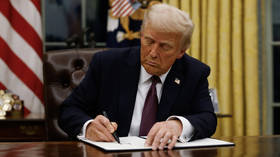Ukraine unrest slams currency, Russia's $15bn aid crucial to avert further collapse

Violence on Kiev’s streets has sent the hryvnia to an almost 4-year low, with bond yields jumping 3 percentage points. Ukraine’s future economy depends on whether Russia delivers the promised $15 billion aid on time and in full, Chris Weafer told RT.
Watch LIVE UPDATES on Ukraine’s protests here.
Since early December, the hryvnia has lost 3 percent, falling to 8.44 against the dollar. In the last 12 months the Ukrainian currency depreciated by 4 percent, with almost half of the decrease taking place in the past week, says the Financial Times.
Any further devaluation is hardly likely, as the Ukrainian government is determined to keep the hryvnia pegged to the US Dollar, Chris Weafer, senior partner at Moscow-based consulting firm, Macro Advisory, told RT in an emailed note.
“But it does depend on Russia actually sending all of the promised aid (so far $3 billion of the promised $15 billion has been delivered), and that will clearly depend on the government regaining political control,” he said.
The country’s bonds also weren’t left untouched. After the killing of three anti-government protesters was reported, the yield of Ukraine’s international dollar bond, expiring later this year, jumped by almost 3 percent points to 9.3 percent on Wednesday. The yields on the longer-term Ukraine bond - to mature in 2023 - have also risen by more than half a percentage point to 8.52 percent.
However, the plunge hasn’t been dramatic, especially when compared to what was happening late last year before Ukraine agreed on a $15 billion financial bailout from Russia, Weafer said.
“Here also the key issue is whether Russia will deliver the full $15 billion promised. If it does then there is no default risk and bond yields should remain relatively stable,” said Chris Weafer.
“If the political situation worsens and the government loses control then the Russia payments could be delayed until there is clarity and stability. In that case, the default risk would increase…. But, for now, investors assume the rescue deal will remain intact and default is not a risk,” the analyst concluded.














